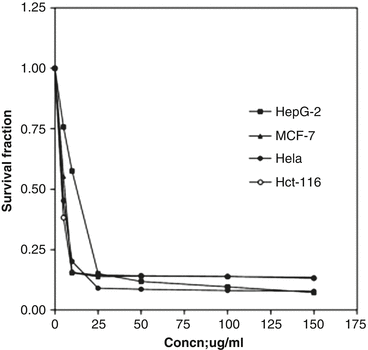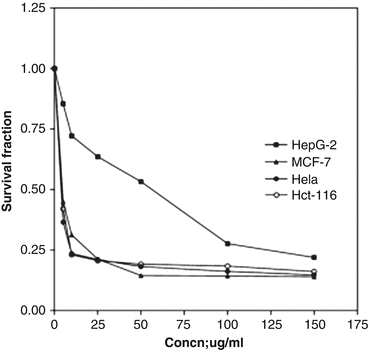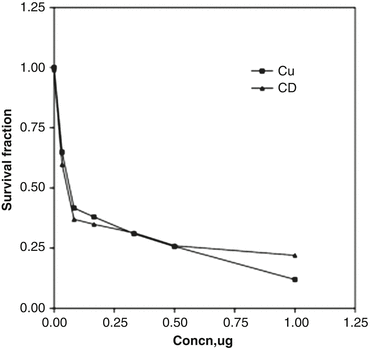Conc. μg/mL
0
25
50
75
100
Compound
Viable cells, %
GH
100
76
15
0
0
GM
100
65
50
40
40
GL
100
75
56
60
60
GA
100
100
90
90
80
Two new derivatives of cationic germanium metal based surfactants have been synthesized (Morsy et al. 2009b). Their formulas are [GeCl2(R)4]2+FeCl4 2− and [GeCl2(R\)4]2 + SnCl4 2−.2H2O where R = hexamine and R\ = isothiouronium. A third derivative of cationic titanium metal based surfactants was also synthesized and its formula is [TiCl2 (R\\)2]2+ CoCl4 2−.6H2O where R\\ = tri-phenylphosphine. Cytotoxic activities of these three metallosurfactants were tested on human cell lines: leukemia lymphoblastic NALM-6 cells, promyclocytic HL-60 cells and breast adenocarcinoma MCF-7 cells. The obtained data revealed that the compound A did not exert cytotoxicity toward normal lymphocytes and was inactive against all tumor cell lines tested. However, compounds B and C displayed high cytotoxicity in tumor cells and low toxicity in human normal lymphocytes, with concurrent high genotoxicity in all kinds of cells. All of these synthesized metallosurfactants induced oxidative DNA damage as detected by alkaline comet assay. Therefore, novel cationic germanium and titanium metal-based surfactants may be considered for use as anticancer drugs, but further studies should be performed.
8.2.2 Cationic Tin-Based Surfactants
A series of cationic tin-based surfactants were synthesized via complexing 8-hydroxyquinoline with tin (IV) chloride at different molar ratios (1:1, 2:1, 3:1, 4:1). Another mixed ligand tin surfactant was prepared from 8-hydroxyquioline, laurylamine, and tin (IV) chloride at molar ratio 3:1:1 (Badawi et al. 2009a).
The mortality % of hepatocellular carcinoma (HepG2) cells line under different concentrations of cationic tin-based surfactants (I–V) was shown in Table 8.2. Data show that the synthesized compounds I and II were able to exert the antiproliferative effects toward the human liver cancer cell line (HepG2) tested. The IC50 values which is the concentration required for 50 % growth inhibition of synthesized compounds toward HepG2 cell viability were 6.52 and 3.44 μg/ml, respectively. Comparatively, cisplatin, a drug with antineoplastic activity, was used in this study.
Table 8.2
Mortality % of hepatocellular carcinoma (HepG2) cells line under different concentrations of cationic tin-based surfactants
Compounds | Concentrations | HepG2 | |||
|---|---|---|---|---|---|
10 μgm (%) | 5 μgm (%) | 2.5 μgm (%) | 0 μgm (%) | IC50 μgm | |
Cisplatin | 100 | 100 | 33.5 | 0.0 | 3.70 |
I | 92 | 46 | 10 | 0.0 | 5.42 |
II | 94 | 47 | 23.5 | 0.0 | 5.32 |
III | 10 | 5 | 3 | 0.0 | −ve |
IV | 10 | 6 | 5 | 0.0 | −ve |
V | 89.5 | 44.5 | 22.5 | 0.0 | 5.59 |
The cationic tin-based surfactants exhibit good interaction by the different cell membranes due to their surface activity.
8.2.2.1 Metallosurfactants
In vivo antitumor activity, liver function, and hematological and antioxidant status of copper cetyltrimethylammonium bromide surfactant (Cu-CTAB)-loaded cyclodextrin nano-analogue were evaluated against Ehrlich ascites carcinoma (EAC) tumor in mice (Badawi et al. 2012a). Mice were then sacrificed for estimation of simultaneous alterations in the hematological profile, liver biochemical parameters, antioxidant status and histopathological changes. The cardiotoxic effect represents in measuring lactate dehydrogenase and creatine phosphokinase enzymes of both compounds and doxorubicin were investigated in rats.
The in vitro anticancer activity of copper cetyltrimethylammonium bromide surfactant (Cu-CTAB)-loaded cyclodextrin nanoparticles on Ehrlich ascites carcinoma (EAC), colon cancer cells (HCT 116), liver cancer cells (HepG-2), breast cancer cells (MCF-7), and cervix cancer cells (Hela) was investigated using MTT due assay (Badawi et al. 2009b). Cyclodextrin nanoparticles loaded with Cu-CTAB exerted in vitro anticancer activity against the previous human cancer cell lines comparable to the activity of free non-entrapped in nanoparticle macro-particle Cu-CTAB as shown in Figs. 8.1, 8.2, and 8.3. The nano-analogue was synthesized by physical loading using grinding with ball mill. The ratio between Cu-CTAB and cyclodextrin oligosaccharide was (1 Cu-CTAB: 3 cyclodextrin). It was found that copper (II) complex surfactants affect tumor tissue at very low concentrations at values lower than their cmc values, which means that there is a strong relationship between the very small values of cmc of these compounds and the ability to reach IC50 values under very low concentrations. This is due to the fact that increasing the concentration of cationic surfactant causes an increase in the adsorption process on cell membranes till the cmc is reached; after this the adsorption slowly decreases and then stops due to the formation of micelles, which prevents mobility and suppresses antitumor activity.




Fig. 8.1
Cytotoxicity of free Cu (II)-CTAB on HepG-2, MCF-7, Hela, Hct-116 cell lines

Fig. 8.2
Cu(II)-CTAB-loaded cyclodextrin nanoparticles on HepG-2, MCF-7, Hela, HCt-116 cell lines

Fig. 8.3
Cytotoxicity of free Cu-CTAB and Cu-CTAB-loaded cyclodextrin nanoparticles on EAC cells
The development of anticancer metal-based surfactant drugs was attempted by reacting dodecyl amine with selenious acid to produce a quaternary ammonium surfactant, which was then converted to copper and cobalt cationic surfactant complexes via complexing the first compounds with copper (II) or cobalt (II) ions (Badawi et al. 2007). Antitumor activity was tested by using Ehrlich ascites carcinoma (EAC) as a model system of mice cell tumor. The compounds were also tested in vitro on five human monolayer tumor cell lines: MCF (breast carcinoma), HEPG2 (liver carcinoma), U251 (brain), HCT116 (colon carcinoma), and H460 (lung carcinoma). The results of its cytotoxic activity on human cell lines revealed IC50 on H460 (lung carcinoma), HCT116 (colon carcinoma), and (brain tumor) U251 of 1.1, 9.6, and 8.7 ug/ml, respectively.
Stay updated, free articles. Join our Telegram channel

Full access? Get Clinical Tree








